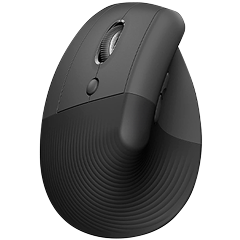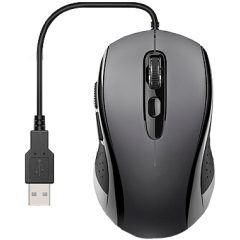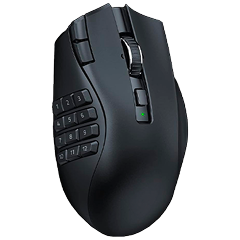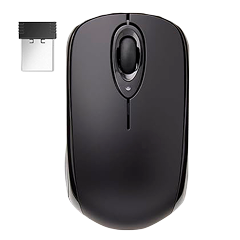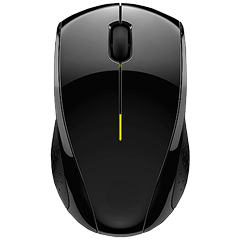Being left-handed in a right-handed world has always come with its little quirks. From scissors to spiral notebooks to exam desks at school, it often feels like things weren’t designed with lefties in mind. The same often goes for mice. If you’ve ever tried to game, edit, or just browse the web using a mouse that clearly wasn’t made for your dominant hand, you’ll know the frustration. But thankfully, things are getting better.
We’ve created this guide for all the lefties out there. Whether you’re looking for a mouse that fully supports your left-handed grip, something ambidextrous, or even a right-handed mouse that can be adapted with a bit of software trickery.
We’ll walk through the types of left-handed mice that are available, what features matter most for left-handed users, and how to avoid the usual pitfalls. If you’re a leftie looking to make your setup more comfortable, there are good options out there, you just need to know where to look and we’re here to point you in the right direction.
Why Left-Handed Mice Matter
Let’s start with the obvious: left-handed mice are all about delivering the same level of comfort and control that right-paws have enjoyed over the years. If you’re left-handed and using a mouse designed for a right-handed grip, you’re constantly fighting an uphill battle and while you might be able to get away with it for a quick couple of clicks, it’s not a fun experience in the long run.
Your fingers don’t fall naturally onto the buttons, the shape pushes your palm in the wrong direction, and any side buttons—often critical in gaming or productivity—are either hard to reach or flat-out unusable.
Using a mouse that’s actually designed for your dominant hand makes such a noticeable difference. Movements feel more precise, you don’t have to stretch awkwardly to reach controls, and over time, proper ergonomics can reduce the strain on your wrist and fingers. That said, not every left-handed user needs a mouse made solely for left-handed use. Some ambidextrous and semi-customizable designs can offer a good middle ground, especially if you share your setup with someone else or just prefer a neutral shape.
Getting to Grips With Left-Handed Mouse Options
When it comes to mice suitable for our southpaws, there are three main categories that might get the job done. Let’s break down the top options and the strengths and weaknesses of each.
True left-handed mice
Pretty simply, fully left-handed mice are a mirrored version of a ‘normal’ mouse (we’re not saying you lefties are not normal, promise). They’re designed with the same ergonomics as popular right-handed models, but flipped to deliver the same native benefits for left-hand use.
These are uncommon, but they do exist and you’ll generally find them as a specific “left-hand edition” of popular mice. They offer the best fit and feel for dedicated left-handed use, including thumb buttons on the right side.
Ambidextrous mice
These are designed to be equal for all, with a symmetrical shape that works the same in either hand. Although the overall shape will nicely support both hands, most of these still tend to default to right-handed use, meaning the extra buttons are on the left side of the mouse. A few ambidextrous models come with buttons on both sides, or let you swap button functions in software, making them genuinely lefty-friendly.
Semi-left-handed mice
While they don’t necessarily advertise their left/right credentials, we consider a semi-left-handed mouse to be a right-handed mouse without an aggressively grooved shape, and that allows you to fully remap buttons, invert tracking orientation, or otherwise tweak them in software. They’re not ideal for dedicated left-hand use, but they can be a workable compromise and a particularly good option in shared setups.
Above all, the most important thing is to choose a category that fits your needs, not just your dominant hand. Some left-handed users prefer ambidextrous mice for their neutral shape and can overlook non-perfect ergonomics, while others want a fully mirrored ergonomic experience for completing long work days in comfort. It’s all about what feels natural for you.
What to Look for in a Left-Handed Mouse
Once you’ve narrowed down the overarching type of mouse you want, there are a few key features to focus on. These aren’t all specific to left-handed mice, in fact many are just true of shopping for mice in general, but these are the kinds of elements we consider when comparing and reviewing mice. Think about features that will affect how comfortable, usable, and effective the mouse will be in your daily routine.
Comfort is number one for a left-handed mouse. This includes everything across shape, size, and grip compatibility. Think about how you hold your mouse, whether you use a palm grip or claw grip, and look for models that match that style.
Larger hands might need a longer or wider body to avoid cramping, while smaller hands benefit from a shorter, lower profile. If you play or work for long hours, a mouse that feels effortless to hold will pay off in reduced fatigue and better performance. Unfortunately you’ll be far more limited for choice with left-handed mice, but there are still options.
Next is button layout and this is where left-handed users really have to pay attention. True left-handed mice should have side buttons under your left thumb, on the right side of the mouse. Ambidextrous models might have side buttons on both sides but many will just have them on the left. In that case, you’ll need to either remap (or even disable) them in software which is far from ideal. If you use thumb buttons a lot in games or for productivity macros, this can make or break the experience.
Just because it’s a left-handed mouse, doesn’t mean you should have to suffer when it comes to performance. Sensor quality is as important here as it is on any other mouse and the same principles apply. For general use and browsing, just about any modern optical sensor will be good enough.
But if you’re gaming, especially in fast-paced shooters or precision-heavy games, you’ll want a mouse which puts a little more effort into its spec sheet. Many of the top brands offer dedicated left-handed mice, so check our full gaming mouse buying guide for more details on what to look for in a sensor and apply this to the limited range of left-handed gaming mice.
And finally, don’t underestimate software. Whether you’re remapping buttons, customizing DPI settings, or storing onboard profiles, a good software suite makes setup and day to day use much easier. For left-handed users in particular, being able to easily flip button functions or change layouts without hassle is a real plus. Some mice store these settings directly onboard, which is ideal if you move between computers, and most will offer profiles to easily change a handful of settings at once—great if you’re sharing an ambidextrous mouse with a righty.
Gaming with a Left-Handed Mouse
Let’s focus on gaming specifically for a second, because this is where left-handed users often face the biggest challenges. Most gaming mice are right-handed by design, with side buttons, contours, and features that just don’t translate well for being used with the ‘wrong’ hand. There are some great options out there, you just need to know which ones are actually lefty-friendly.
If we’re being realistic, for the maximum amount of choice it’s ambidextrous gaming mice that are your best bet here, rather than something dedicated. These are often lightweight, highly responsive, and symmetrical in shape, making them perfect for high-level or competitive gaming. Models from Logitech, Razer, SteelSeries, and Zowie often fall into this category. Some of them even include side buttons on both sides, so you can pick your preferred layout.
True left-handed gaming mice do exist, but they’re a little harder to find and there is much, much less choice. Razer, for example, has released left-handed versions of some of their most popular mice over the years, though availability has seemingly always been inconsistent. If you find one, it can be a fantastic fit for MMOs, MOBAs, or RPGs where thumb buttons and ergonomic shape make a big difference.
Using a Left-Handed Mouse Day to Day
Ambidextrous or ergonomic left-handed models with programmable buttons can really shine for general use. If you’re a creative person doing video editing, graphic design, or just working between a lot of apps and documents, having side buttons under your left thumb can speed things up. And even if you only use left-click, right-click, and scroll wheel, having a shape that suits your hand will reduce tension and repetitive strain over time.
Wireless left-handed mice are a little more common in the productivity space than in gaming, with several models available from Microsoft, Logitech, and smaller challenger brands too. These usually focus more on battery life and comfort than high-end specs, which is perfect for long days at your desk completing potentially repetitive tasks.
Things to Watch Out for When Shopping for Left-Handed Mice
There are a few specific pitfalls to avoid when shopping for a left-handed mouse and a lot of them are about keeping your wits about you and digging deeper beyond the marketing headlines.
First, be cautious with models that make throwaway claims of being “ambidextrous” and make sure these are actually worth the webpage they’re written on. Some will play fast and loose with what they determine as ambidextrous, pay close attention to product images, shape and button layout to make sure things stack up.
Also be careful with budget models from less-well-known brands that claim to offer left-hand support but skimp on build quality as a result. Mushy buttons, stiff scroll wheels, and poor sensor performance can make the whole experience frustrating. You’ll need to rely on social chatter and reviews to get a sense for this, but make sure to do your research. You don’t need to spend a fortune, but aim for something built to last.
You may need to flip the order of your search when looking for a left-handed mouse as availability can be a tricky thing, with some models only releasing as limited runs or disappearing off shelves after just a year or two. There’s no point doing a load of research and getting your heart set on the perfect lefty mouse, only to discover it’s no longer available anywhere. Check what options are actually available first, short list them, then compare based on what’s currently in stock and ready to ship.
On the Flip Side
Left-handed mice have come a long way, even if specific models aren’t as common as their right-handed siblings and availability can be a little shakey. Whether you’re gaming, working, or just want a more natural fit, there’s a good chance you can find something that suits your grip, playstyle, and workflow.
The key is to figure out what kind of mouse you want, whether that’s a true left-handed, ambidextrous, or semi-lefty fit, and go from there based on what’s available. Look for comfortable shapes, accessible button layouts, and customizable software that helps you get the most out of your mouse. A little bit of research goes a long way and the payoff can be massive.


